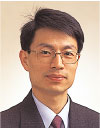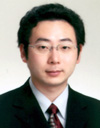|
|
 |
|
|
Multimedia Systems Laboratory |

Noriaki Asada
Professor |

William L. Martens
Associate Professor |

Jung-pil Shin
Assistant Professor |

Hirohide Demura
Assistant Professor |
|
Recognition, analysis and expression of images and sounds are studied in the multimedia systems laboratory.
The 3-D motionand the 3-D shapes of the object are analyzed, understood and expressed by computer from the images taken by multi TV camera or video camera in the study of computer vision and/or the 3-D stereovision. Detailed movies can be seen from any angle through the 3-D video system, which is expected to be applied to many fields such as the sports coaching and the recognition of the human facial expression.
In the remote sensing, the category classification technique can analyze the land usages from color information of land images. A laboratory member is engaged in the SELENE project, the Japanese lunar explorer mission, to analyze the lunar mineral composition and to investigate the future moon surface land usage. Moreover, by applying this technique to the computer vision, even the living body information of the human being can be known, too.
Furthermore, we are engaged also in space exploration programs in Japan including planetary and an asteroid exploration inquiry plan. Especially, in the asteroid probe program "MUSES-C" scheduled to launch in 2003, we are responsible for the determination of the landing point on the asteroid and for guide to land on the asteroid by the use of the 3-dimensional recognition technology of the computer vision.
In the on-line handwriting character recognition system, the fundamental study to use the handwriting letter as the input system of the computer is investigated. The character recognition is one of the most important fields on the image processing.
Just as 3D graphic rendering can produce realistic views of virtual spaces, so can3D audio renderingproduce realistic sounds for objects andevents in those virtual spaces, called "Virtual Acoustic Space". State-of-the-art 3D audio rendering is based upon acoustical measurements.
Laboratory members have participated actively in scientific meetings, both in Japan and abroad. They have presented and participated in seminars, and in presentation of scientific results in fully refereed publications.
|
| [demura-01:2002] | H. Demura and K. Kurita. A shallow volatile layer at Chryse Planitia, Mars. Earth, Planets, and Space, 50:423-429, 1998.
a work of previous position |
| [demura-02:2002] | H.Demura. Formation of the fiidized craters on Mars. Planetary People, 9(1):5-16, 2000.
a work of previous position |
| [demura-03:2002] | H. Demura, Y. Nishikawa, and T. Takata. Formation of the fiidized craters on Mars. Planetary People, 10(4):202-207, 2001.
a work of previous position |
| [demura-04:2002] | H. Demura. Power-law indices of asteroidal grooves and strength. Earth, Planets, and Space, 53:1065-1069, 2001.
a work of previous position |
| [demura-05:2002] | T. Nakamura, A. Nakamura, J. Saito, S. Sasaki, R. Nakamura, H. Demura, H. Akiyama, D. Tholen, and AMICA team. Multi-band imaging camera and its sciences for the Japanese near-Earth asteroid mission MUSES-C. Earth, Planets, and Space, 53:1047-1063, 2001.
a work of previous position |
| [jpshin-01:2002] | Jungpil Shin. Optimal Stroke-Correspondence Search Method for On-Line Character Recognition. Pattern Recognition Letters, 23(2):601-608, 2002.
This paper describes an optimal stroke-correspondence search method that makes possible stroke-order-freeonline character recognition. Duringthe stroke-correspondence search process, conventional individual stroke-information regarding the shape and position of each stroke, and interstroke-information regarding themutual relationships among strokes are both employed. The optimal path search for stroke-correspondence, being based on an optimal criterion including both intra- and interstroke-information, is systematically carried out. The reasonable level stroke-correspondencesearch is achieved partially by using the information regarding the actually occurring stroke-order, which does not hinder the framework of stroke-order-free recognition due to its use of statistically stable information. A large improvement in both computational time and recognition-accuracy were achieved in the current experiments. |
| [jpshin-02:2002] | Jungpil Shin. Stroke Order- andNumber-Free On-Line Character Recognition Using Intra- and Inter-Stroke Information. International Journal of Knowledge-Based Intelligent Engineering Systems, 6(2):72-79, 2002.
This paper describes a new stroke correspondence search algorithm applied to stroke order- and stroke number-free on-line character recognition. Inter-stroke information on the mutual relation among strokes and conventional individual stroke information on the shape and position of each stroke are both employed. The optimal path search for stroke correspondence, being based on an optimal criterion that includes inter-stroke information, is systematically carried out by a dynamic programming(DP) equation that provides robustness for exceptional user-generated stroke deformations. In addition, high recognition capability, as well as computational feasibility, are experimentally demonstrated. |
| Referred Proceeding Papers |
| [asada-01:2002] | N. Asada and H.Watanabe. A New Image Interpolation Method. In Editor Hamid R. Arabnia, editor, Proceedings of the International Conference on Imaging Science, Systems, and Technology (CISST '99), pages 215-220, Las Vegas, June 1999. CSREA, CSREA press.
A new image interpolation method considering the difference betweeen sampling interval and sampling time is proposed. |
| [asada-02:2002] | Horiuchi K. Asada, N. and H. Watanabe. Progressive Improvement of Multi-band Image Analysis. In V. V. Kluev and Editor N. E. Mastorakis, editors, Proceedings of the WSES International Conference on Speech, Signal and Image processing (SSIP '01), pages 1651-1657, Athens, September 2001. WSEAS, WSES Press.
A progressive method is proposed in the field of category classification and composition analysis using multi-band remote sensing images. |
| [asada-03:2002] | N. Asada and M. Ogura. 3D Interpolation Method for CTImages of the Lung. In J. Zhou N. Callaos and Editor S. Nobesawa, editors, Proceedings of the 6th World Multiconference on Systemics, Cybernetics and Informatics (SCI 2002), volume 3, pages 11-16, Orland, July 2002. IIIS, IIIS.
An attempt to reconstruct a 3-D lung image by a series of such operations without discontinuity is shown. Additionally, the same geometrical transformation method to the original projection images is proposed as a more advanced method. |
| [demura-06:2002] | H. Demura, N. Hirata, J. Haruyama, K. Matsui, M. Kato, and SELENE Data Processing WG. Design of the Moon Database used to integrate the SELENE data. In 23rd International Symposium on Space Technology and Science, pages 2006-2009. 23rd International Symposium on Space Technology and Science, 2002.
a work of previous position |
| [demura-07:2002] | N. Hirata, J. Haruyama, M. Ohtake, T. Matsunaga, H. Demura, and LISM working group. Ground data processing of Lunar Imager/Spectrometer (LISM):Asystem designandcore altorithms. In23rd International Symposium on Space Technology and Science, pages 2001-2005. 23rd International Symposium on Space Technology and Science, 2002.
a work of previous position |
| [asada-04:2002] | V. V. Kluev and Editor N. E. Mastorakis, editors. Advances in Signal Processing, Robotics and Communications, pages 1651-1657. Electrical and Computer Engineering Series. WSES Press, Athens, 2001. |
| [jpshin-03:2002] | Jungpil Shin. On-Line Handwriting Character Recognition Using Stroke Information, pages 703-714. Number 5 in Lecture Notes in Artificial Intelligence. Springer-Verlag, Australia, 2002. |
| [jpshin-04:2002] | Jungpil Shin. Research Funds for Internatianal Conference from The Telecommunications Advancement Foundation, 2002, June. |
| [jpshin-05:2002] | Jungpil Shin, Sep. 2002. Member of the Program Committee, The Third International Conference on Computer and Information Technology (CIT2002) |
| [jpshin-06:2002] | Toshihiro Okabe. Graduation Thesis: On-Line Handwriting Character Dictionary Generation using Analysis of Stroke Variation, University of Aizu, 2002.
Thesis Advisor: Jungpil Shin |
| [jpshin-07:2002] | Kazunori Suzuki. Graduation Thesis: Handwritten Style Font Generation Using Vector Quantization, University of Aizu, 2002.
Thesis Advisor: Jungpil Shin |
| [jpshin-08:2002] | Masato Hoshino. Graduation Thesis: A Rotated Handwritten Character Recognition Technique Using Inter-Stroke Information, University of Aizu, 2002.
Thesis Advisor: Jungpil Shin |
| [jpshin-09:2002] | Kouhei Miura. Graduation Thesis: Personal Identification using Free Text, University of Aizu, 2002.
Thesis Advisor: Jungpil Shin |
| [jpshin-10:2002] | Tetsuro Minagawa. Graduation Thesis: Handwritten Character String Recognition Using Two-level Dynamic Programming, University of Aizu, 2002.
Thesis Advisor: Jungpil Shin |
| [jpshin-11:2002] | Yumi Wakaki. Graduation Thesis: One-to-One Stroke Correspondence Method Using Genetic Algorithm, University of Aizu, 2002.
Thesis Advisor: Jungpil Shin |
|